air condition PONTIAC BONNEVILLE 1996 Owners Manual
[x] Cancel search | Manufacturer: PONTIAC, Model Year: 1996, Model line: BONNEVILLE, Model: PONTIAC BONNEVILLE 1996Pages: 387, PDF Size: 18.71 MB
Page 120 of 387
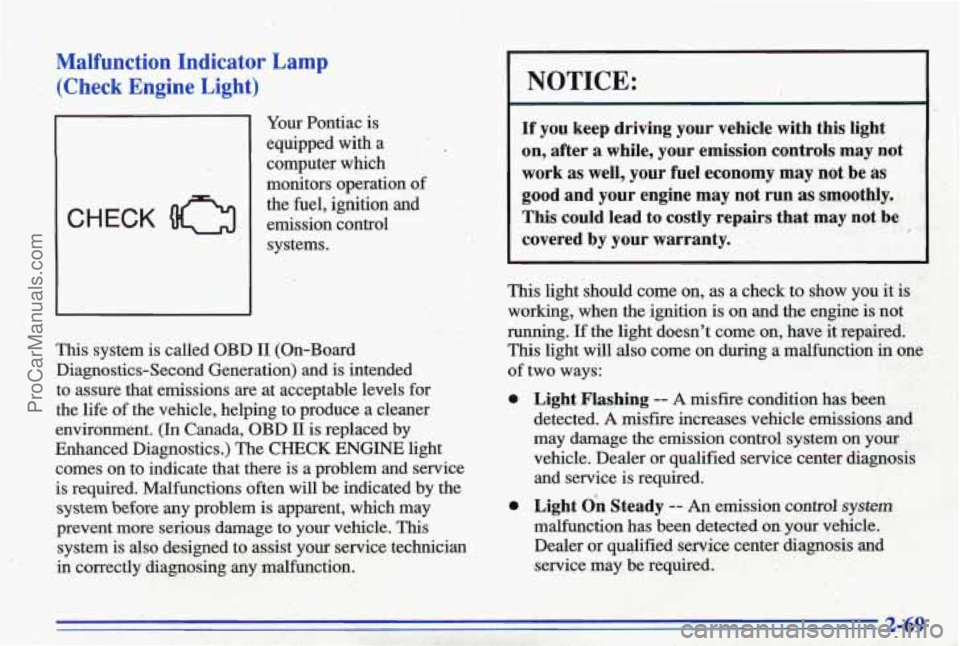
Malfunction Indicator Lamp
(Check Engine Light)
CHECK
Your Pontiac is
equipped with.a
, ' .
computer which
monitors operation of
the fuel, ignition and
emission control systems.
This system is called OBD 11 (On-Board
Diagnostics-Second Generation) and is intended
to assure that emissions are at acceptable levels for
the life of the vehicle, helping to produce a cleaner
environment.
(In Canada, OBD 11 is replaced by
Enhanced Diagnostics.) The CHECK ENGINE light
comes on to indicate that there is a problem and service
is required. Malfunctions often will be indicated by the
system before any problem is apparent, which may
prevent more serious damage to your vehicle.
This
system is also designed to assist your service technician
in correctly diagnosing any malfunction.
NOTICE: 1.
If you keep driving your vehicle with this light
on, after a while, your emission controls may not
work as well, your fuel economy may not be as
good and your engine may not run
as smoothly.
This could lead to costly repairs that may not be
covered by your warranty.
.
This light should come on, as a check to show you it is
working, when the ignition is on and the engine is not
running.
If ,the light doesn't come on, have it repaired.
This light will also come on during a malfunction in one
of two ways:
0
0
Light Flashing -- A misfire condition has been
detected.
A misfire increases vehicle emissions and
may damage the emission control system on your
vehicle. Dealer or qualified service center diagnosis and service is required.
Light On Steady -- An emission control system
malfunction has been detected on your vehicle. Dealer or qualified service center diagnosis and
service may be required.
ProCarManuals.com
Page 122 of 387
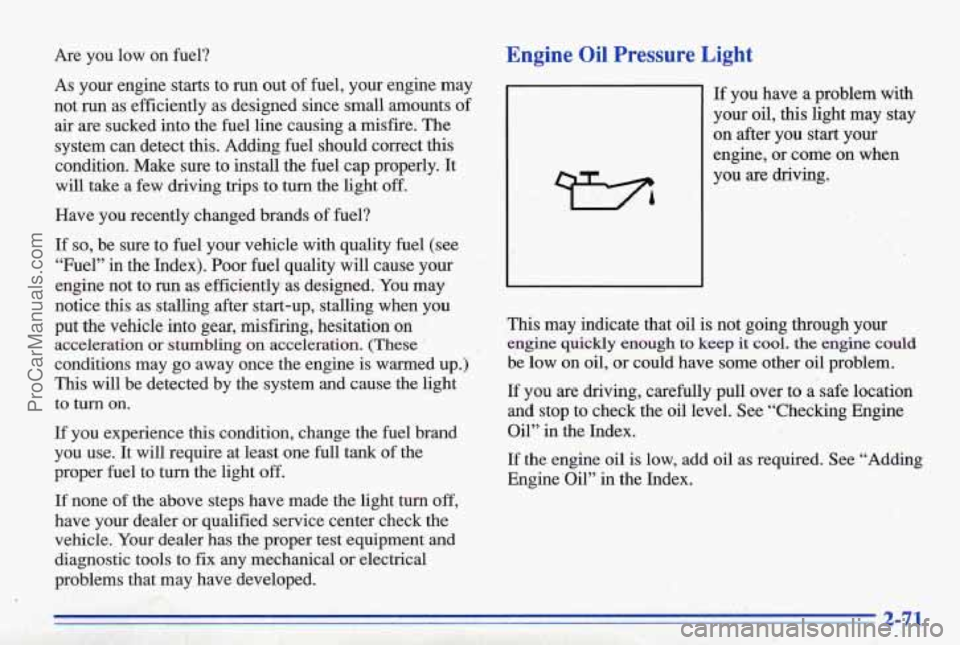
Are you low on fuel?
As your engme starts to run out of fuel, your engine may
not run as’ efficiently as designed since small- amounts
of
air are sucked into the fuel line causing a misfire. The
system can detect this. Adding fuel should correct this
condition. Make sure to install the fuel cap properly. It
will take a few driving ,trips
to turn the light off.
Have you recently changed brands of fuel?
If so, be sure to fuel your vehicle with quality fuel (see
“Fuel”
in the Index). Poor fuel quality will cause your
engine not to run as efficiently as designed.
You may
notice
this as stalling after start-up, stalling when you
put the vehicle into gear, misfiring, hesitation on
acceleration or
stumbling on acceleration. (These ’
conditions may go away once the engine is warmed up.)
This will be detected by the system and cause the light
to
Imn on.
If you experience this condition, change the fuel brand
you use. It will require at least one full tank of the
proper fuel
to turn the light off.
If none of the above steps have made the light turn off,
have your dealer or qualified service center check the
vehicle. Your dealer has the proper test equipment.
and
diagnostic tools to fix any mechanical or electrical
problems that may have developed.
Engine Oil Pressure 1,ig.ht
If you have a problem with
your oil, this light may
stay
on after you start your
engine,
or come on when
you are driving.
This may indicate that oil is not going through your
engine quickly enough to keep it cool. the engine could
be low on oil, or could have some other oil problem.
If you are driving, carefully pull over to a safe location
and stop to check the oil level. See “Checking Engine
Oil” in the Index.
If the engine oil is low, add oil as required. See “Adding
Engine
Oil” in the Index.
3 71
ProCarManuals.com
Page 138 of 387
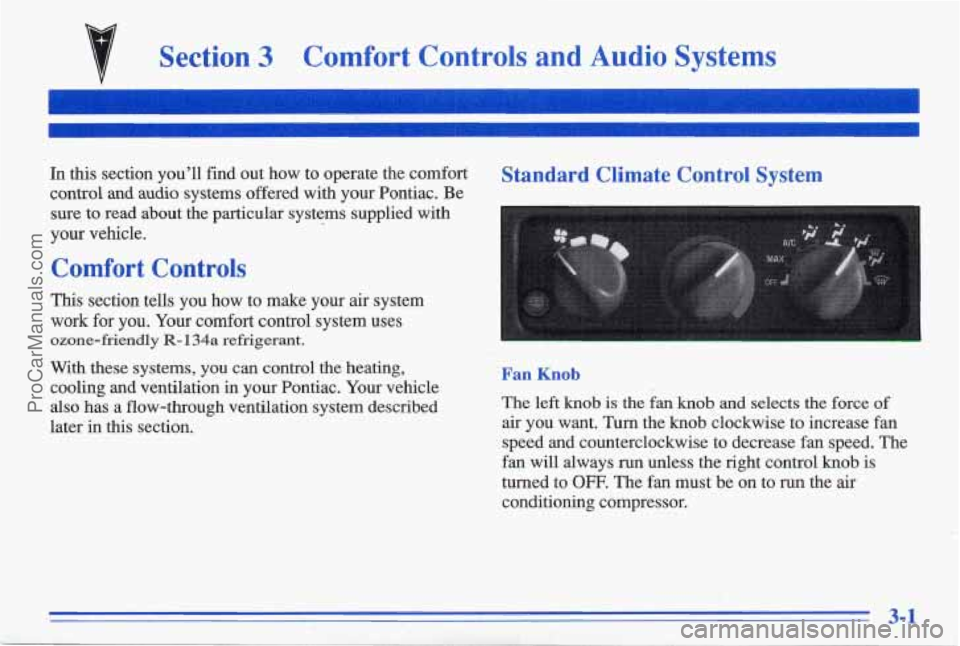
Section 3 Comfort Controls and Audio Systems
In this section you'll find out how to operate the comfort Standard Climate Control System
control and audio systems offered with your Pontiac. Be
sure to read about the particular systems supplied with
your vehicle.
Comfort Controls
This section tells you how to make yo'ur air system
work
for you. Your comfort control system uses
ozone-friendly R- 134a refrigerant.
With these systems, you can control the heating,
cooling and ventilation in your Pontiac.
Your vehicle
also has a flow-through ventilation system described
later in this section. Fan Knob
The left knob is the fan knob and selects the force of
air you want. Turn the knob clockwise to increase fan
speed and counterclockwise to decrease fan speed. The
fan
will always run unless the right control knob is
turned to
OFF. The fan must be on to run the air
conditioning compressor.
3-1
ProCarManuals.com
Page 139 of 387
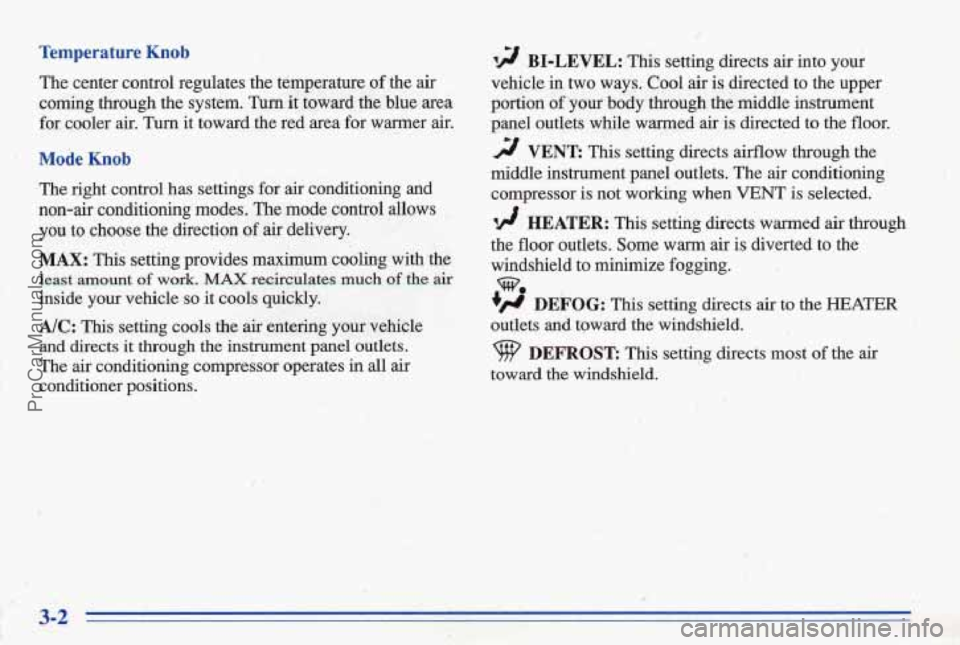
Temperature Knob 12 BI-LEVEL: This setting directs air into your
The center control regulates the temperature
of the air vehicle in two ways. Cool air is directed to the upper
coming through the system. Turn it toward the blue area
portion of your body through the middle instrument
for cooler
air. Turn it toward the red area for wmer air. panel outlets while warmed. air is directed to the floor. CI
Mode Knob
The right control has settings for air conditioning and
non-air conditioning modes. The mode control allows
you to choose the direction of air delivery.
MAX: This setting provides maximum cooling with the
least amount of work. MAX recircdates much of the air
inside your vehicle so it cools quickly.
Mc: his setting cools the air entering your vehicle
and directs it through the instrument panel outlets.
The
air conditioning compressor operates in all air
conditioner positions.
d VENT: This setting directs airflow through the
middle instrument panel outlets. The air conditioning' compressor is not
working when VENT is selected.
I! HEATER: This se&ng directs warmed air through
the floor outlets. Some warm
air is' diverted to the
windshield to minimize fogging.
w.
+H DEFOG: his setting directs &to ~e HEATER
outlets and toward the windshield.
9 DEFROST: This setting directs most of the air
toward the windshield.' . .. . .. . ,' i
3-2
ProCarManuals.com
Page 142 of 387
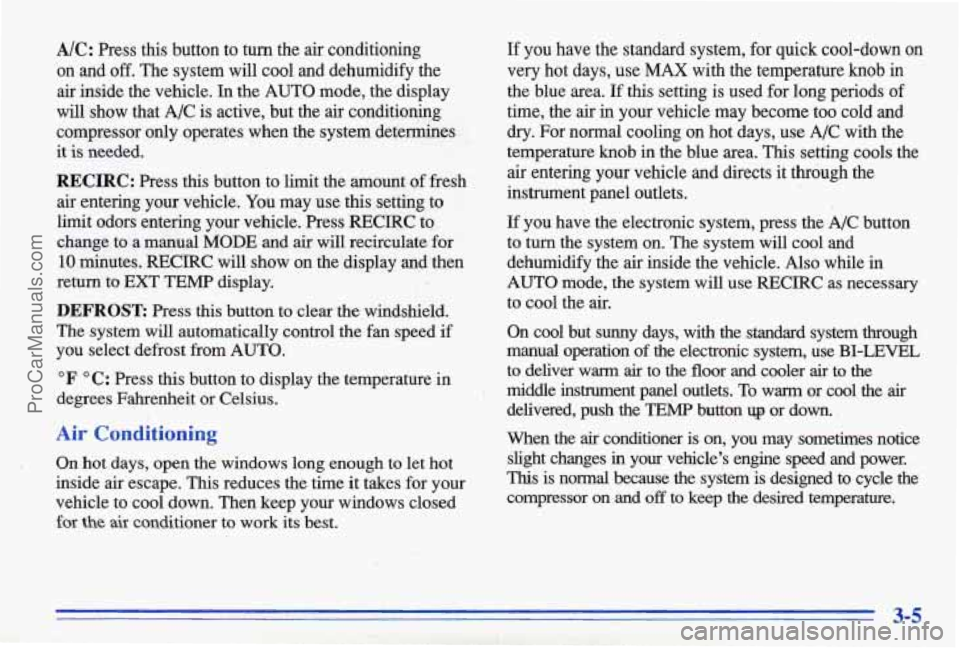
A/C: Press this button to turn the air conditioning
on and
off. The system will cool and dehumidify the
air inside the vehicle.
In the AUTO mode, the display
will show that
A/C is active, but the air conditioning
compressor
only operates when the system determines
it
is needed.
RECIRC,: Press this button to limit the amount of fresh
air entering your vehicle. You may use this setting to
limit odors entering your vehicle. Press
REClRC to
change to a manual
MODE and air will recirculate for
10 minutes. RECIRC will show on the display and then
return to
EXT TEMP display.
DEFROST: Press this button to clear the windshield.
The system will automatically control the fan speed
if
you select defrost from AUTO.
OF O C: ‘Press this button to display the temperature in
degrees Fahrenheit or Celsius.
Air Conditioning
On hot days, open the windows long enough to let hot
inside
air escape. This reduces the time it takes for your
vehicle to cool down. Then keep your windows closed
for the air conditioner to work its best.
If you have the standard system, for quick cool-down on
very hot days,
use MAX with the temperature knob in
the blue area. If this setting is used for long periods of
time, the air in your vehicle may become too cold and
dry. For normal cooling on hot days, use A/C with the
temperature
knob in. the blue area. This setting cools the
air entering your vehicle and directs it through the
instrument panel outlets.
If you have the electronic system, press the A/C button
to
turn the system on. The system will cool and
dehumidify the air inside the vehicle.
Also while in
AUTO mode, the system will use FtECIRC as necessary
to cool the air.
&1 cool but sunny days, with the standard system through
manual operation of the electron& system, use BI-LEVEL
to deliver warm air to the floor and cooler air to the
middle instrument panel outlets. To warrn or cool the
air
delivered, push the TE- button up or down.
When the air conditioner is on, you may sometimes notice
slight changes
in your vehicle’s engine speed and power.
This is normal because the system is designed to cycle the
cornpressor on
and off to keep the desired temperature.
ProCarManuals.com
Page 221 of 387
![PONTIAC BONNEVILLE 1996 Owners Manual If No Steam ]Is Coming From Your Engine
If you get the overheat warning but see or hear no
steam, the problem may not be
too serious. Sometimes
the engine can get
a little too ho PONTIAC BONNEVILLE 1996 Owners Manual If No Steam ]Is Coming From Your Engine
If you get the overheat warning but see or hear no
steam, the problem may not be
too serious. Sometimes
the engine can get
a little too ho](/img/50/58379/w960_58379-220.png)
If No Steam ]Is Coming From Your Engine
If you get the overheat warning but see or hear no
steam, the problem may not be
too serious. Sometimes
the engine can get
a little too hot when you:
Climb a long hill on a hot day.
0 Stop af'ter high-speed driving.
Idle for long periods in traffic.
0 Tow a trailer.
If you get the overheat warning with no sign of stem,
try this for a minute or so:
1. Turn off your air conditioner.
If you no longer have the overheat warning, you can
driv'e. Just to be
safe, drive slower for about 10 minutes.
If
the warning doesn't come back on, you can
driv'e normally.
If the warning continues, pull over, stop, and park your
vehicle right away.
If there's still no sign of steam, you can idle the engine
for'two or three minutes while you're parked, to see
if the warning stops. But then, if you still have the
warning, turn oJjcthe engine and get everyone out of
the vehicle until it cools down.
You may decide not to lift the hood but to get service
help right away.
2. Turn on,your heater to full hot at the 'highest fan
3. If you're in a traffic jam, shift to NEUTRAL (N);
speed and open the window as necessary.
otherwise, shift to
the highest gear while
or DRIVE (D).
driving -- AUTUMbaTz[c OVERDRIVE (@)
5-16 ProCarManuals.com
Page 248 of 387
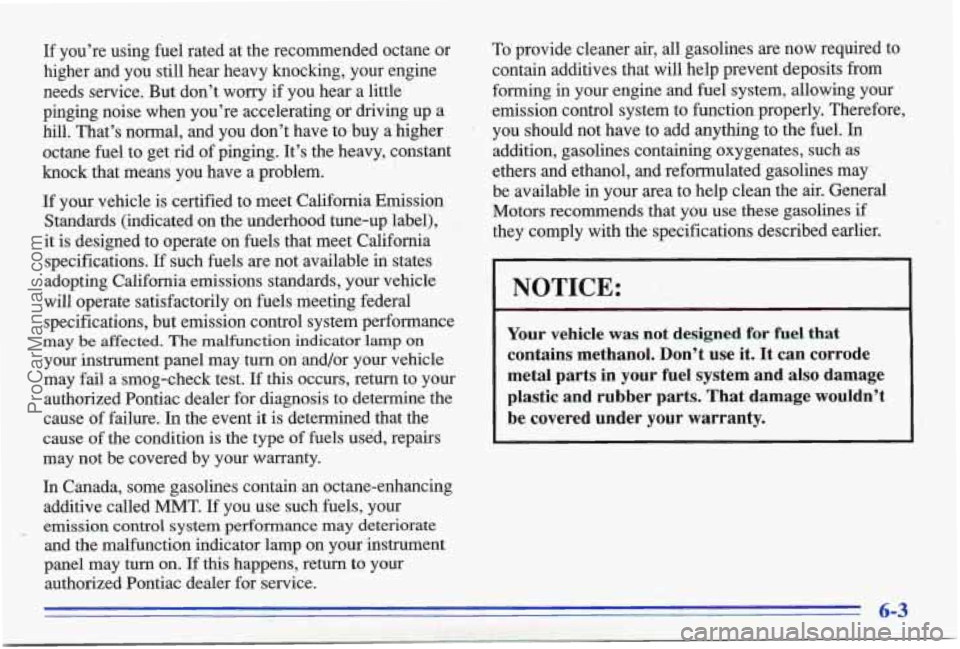
If you’re using fuel rated at the recommended octane or
higher and you stiil hear heavy knocking, your engine
needs service. But don’t worry
if you hear a little
pinging noise when you’re accelerating or driving up
a
hill. That’s normal, and you don’t have to buy a higher \
octane fuel to get rid of pinging. It’s the heavy, constant
knock that means you have a problem.
If your vehicle is certified to meet California Emission
Standards (indicated on the underhood tune-up ’label),
it is designed to operate on fuels that meet California
specifications.
If such fuels are not available in states
adopting California emissions standards, your vehicle
will operate satisfactorily on fuels meeting federal
specifications, but emission control system performance
may be eected. The malfunction indicator lamp on
your instrument panel may turn on and/or-your vehicle may fail a smog-check test.
If this occurs, return to your
authorized Pontiac dealer for diagnosis to determine the
cause of failure.
In the event it is determined that the
cause
of the condition is the type of fuels used, repairs
may not be covered by your warranty.
In Canada, some gasolines contain an octane-enhancing
additive called MMT.
If you use such fuels, your
, emission control system performance may deteriorate
and the malfunction indicator lamp on your instrument
panel may turn on.
If this happens, return to your
authorized Pontiac dealer for service.
To provide cleaner air, all gasolines are now required to
contain additives that will help prevent deposits from
forming in your engine and fuel system, allowing your
emission control system to function properly. Therefore,
you should not have to add anything
to the fuel. In
addition, gasolines containing oxygenates, such as
ethers and ethanol, and reformulated gasolines may
be available in your area to help clean the air. General
Motors recommends that you use these gasolines
if
they mcomply with the specifications described earlier.
NOTICE:
Your vehicle was not designed for fuel that
contains methanol. Don’t use it. It can corrode
metal parts in your fuel system and also damage
plastic and rubber parts. That damage
wouldn’t
be covered under your warranty.
ProCarManuals.com
Page 257 of 387
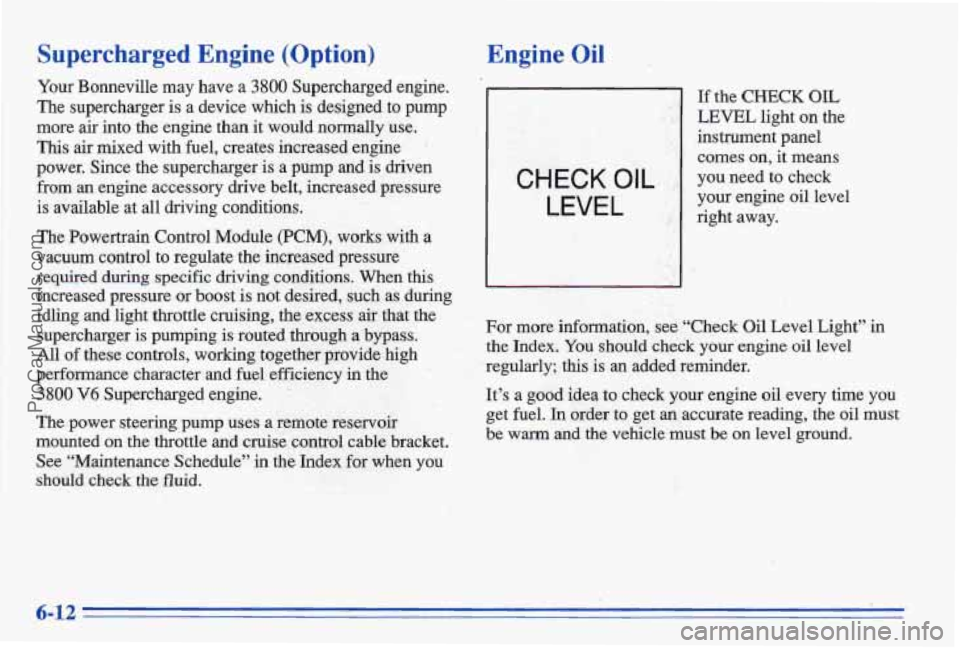
Supercharged Engine (Option)
Your Bonneville may have a 3800 Supercharged engine.
The supercharger is a device which is designed
to pump
more
air into the engine than it would normally use.
This air mixed with fuel, creates increased engine
power. Since the supercharger is a pump
and is driven
from an engine accessory drive belt, increased pressure
is available at all driving conditions.
The Powertrain Control Module (PCM), works with a
vacuum control to regulate the increased pressure
required
during specific driving conditions. When this
increased pressure or boost is not desired, such as during
idling
and light throttle cruising, the excess air that the
supercharger is pumping is routed through
a bypass.
All of these controls, working together provide high
performance character
and fuel efficiency in the
38010 V6 Supercharged engine.
The-power steering pump uses a remote reservoir
mounted on the throttle and cruise control cable bracket.
See “Maintenance Schedule”
in the Index for when you
should check the fluid.
I ’. .. ,- .. .. , . -. :? 1
Engine Oil
CHECK OIL
LEVEL
If the CHECK OIL
LEVEL light on the
instrument panel comes
on, it means
you need to check
your engine oil level
right away.
For more information, see “Check Oil Level Light”
in
the Index. You should check your engine oil level
regularly; this is
an added reminder.
It’s a good idea
to check your engine oil every time you
get fuel. In order to get an accurate reading, the oil must
be warm and the vehicle must be on level ground.
6-12
ProCarManuals.com
Page 292 of 387
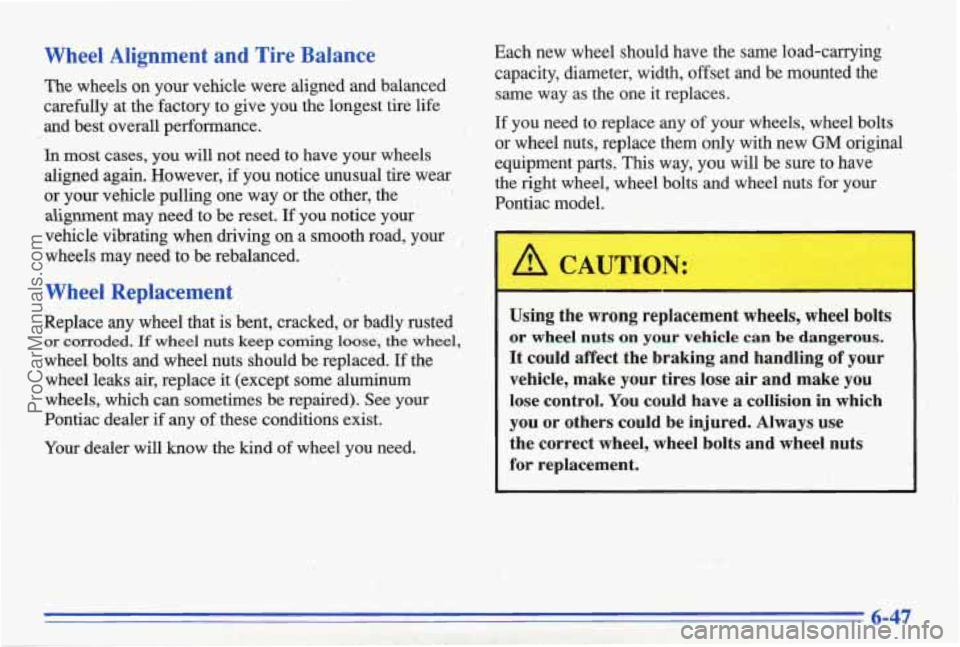
Wheel Alignment and Tire Balance
The wheels on your vehicle were aligned and balanced
carefully at the factory to give you the longest tire life
and best overall performance.
In most cases, you will not need to have your wheels
aligned again. However,
if you notice unusual tire wear
or
your vehicle pulling one way or tlie other, the
ahgnment may need to be reset. If you notice your'
vehicle vibrating when driving on a smooth road, your wheels may need' to be rebalanced.
, ,
Wheel Replacement
Replace any wheel that.is bent, cracked, or badly rusted
or corroded. If wheel nuts keep coming loose, the wheel,
wheel bolts and wheel nuts should be replaced. If the
wheel leaks air, replace it (except some alumhum
wheels, which can sometimes be repaired). See
your
Pontiac dealer if any of these conditions exist.
Your dealer will know the kind of wheel you need.
.- 1' . . , . .. ;
Each new wheel should have the same load-carrying
capacity, diameter, width, offset and be mounted the same way as the one it replaces.
If you need to replace any of your wheels, wheel bolts
or wheel nuts, replace them
only with new GM origipal
equipment parts.
This way, you will be sure to have
the right wheel, wheel bolts and wheel 'nuts for your
Pontiac model.
I
12 CAUTION:
Using the wrong replacement wheels, wheel bolts
or wheel
nuts on your vehicle can be dangerous.
It could affect the braking and handling of your
vehicle, make your tires lose air and make
you
lose control. You could have a collision in which
you or others could be injured. Always use
the correct wheel, wheel bolts and wheel nuts
for replacement.
6-47
ProCarManuals.com
Page 300 of 387
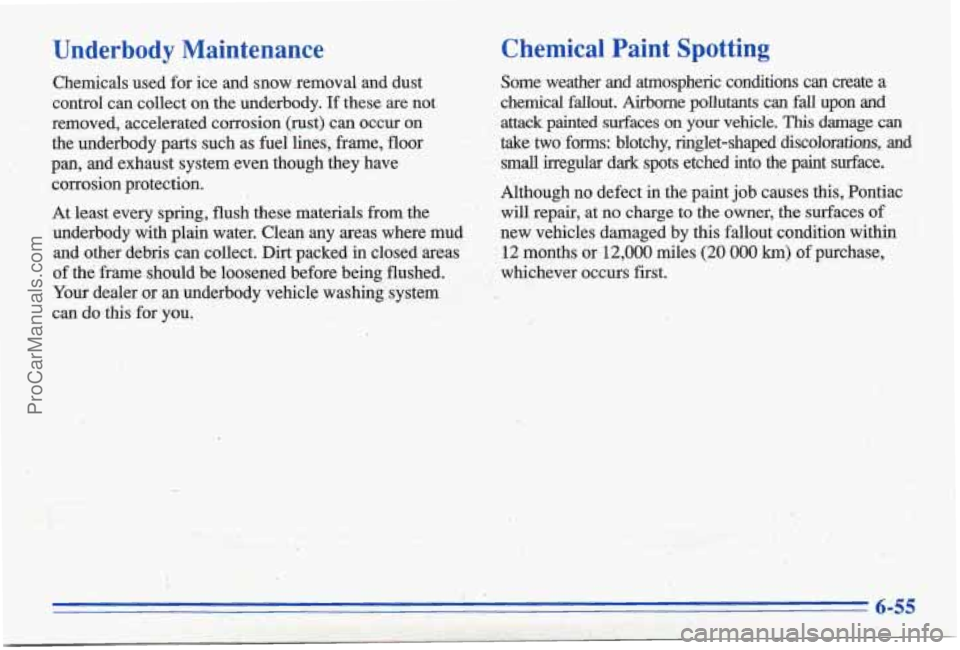
Underbody Maintenance
Chemicals used for ice and snow removal and dust
control
can collect on the underbody. If these are not
removed, accelerated corrosion (rust) can occur on
the underbody parts such as fuel lines, frame,
floor
pan, and exhaust system even though they have
corrosion protection.
At least every spring, flush these materials from the
underbody with plain water. Clean any areas where mud and other debris can collect.
Dirt packed in closed areas
of the frame should be loosened before being flushed.
Your dealer or
an underbody vehicle washing system
can
do this for you.
Chemical Paint Spotting
Some weather and atmospheric conditions can create a
chemical fallout. Airborne pollutants can fall upon and
attack painted surfaces on your vehicle. This damage can .
take two forms: blotchy, ringlet-shaped discolorations, and
small irregular dark spots etched into the paint surface.
Although no defect in the paint
job causes this, Pontiac
will repair, at no charge
to the owner, the surfaces of
new vehicles damaged by this fallout condition within
12 months or 12,000 miles (20 000 km) of purchase,
whichever occurs
first.
ProCarManuals.com